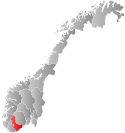|
Vestre Moland
Vestre Moland is a former municipality in the old Aust-Agder county in Norway. The administrative centre of the municipality was the village of Møglestu where the Vestre Moland Church is located. The 103-square-kilometre (40 sq mi) municipality existed from 1838 until 1962 when it was merged into the municipality of Lillesand. Today, the area of Vestre Moland covers the northern part of the present-day municipality of Lillesand in Agder county.[1] Vestre Moland included the island of Justøy and the area surrounding the ladested of Lillesand. It features the lake Østre Grimevann found in the northern part of Vestre Moland and the Blindleia inland waterway which is located along the coast of Vestre Moland. History The municipality (originally the parish) of Vestre Moland was established on 1 January 1838 (see formannskapsdistrikt law). In 1865, the municipality was divided into two separate municipalities of Vestre Moland (population: 2,167)—the northern part and Høvåg (population: 2,069) the southern part. During the 1960s, there were many municipal mergers across Norway due to the work of the Schei Committee. On 1 January 1962, Vestre Moland (population: 2,454) was merged with the municipality of Høvåg, the ladested of Lillesand, and the Gitmark farm area in the municipality of Eide to form a new, enlarged Lillesand municipality.[3] NameThe municipality (originally the parish) is named after the old Moland farm (Old Norse: Móðguland), since the first Vestre Moland Church was built there. The prefix vestre (which means "western") was added to differentiate the place from Austre Moland which was located a little further north along the coast of Norway in present-day Arendal. The first element of the name is derived from the river Móðga. The river name comes from the Old Norse word móðigr which means "brave" or "courageous". The last element is land which means "land" or "district".[4] GovernmentDuring its existence, this municipality was governed by a municipal council of directly elected representatives. The mayor was indirectly elected by a vote of the municipal council.[5] Municipal councilThe municipal council (Herredsstyre) of Vestre Moland was made up of 21 representatives that were elected to four year terms. The tables below show the historical composition of the council by political party.
See alsoReferences
|
||||||||||||||||||||||||||||||||||||||||||||||||||||||||||||||||||||||||||||||||||||||||||||||||||||||||||||||||||||||||||||||||||||||||||||||||||||||||||||||||||||||||||
Portal di Ensiklopedia Dunia



